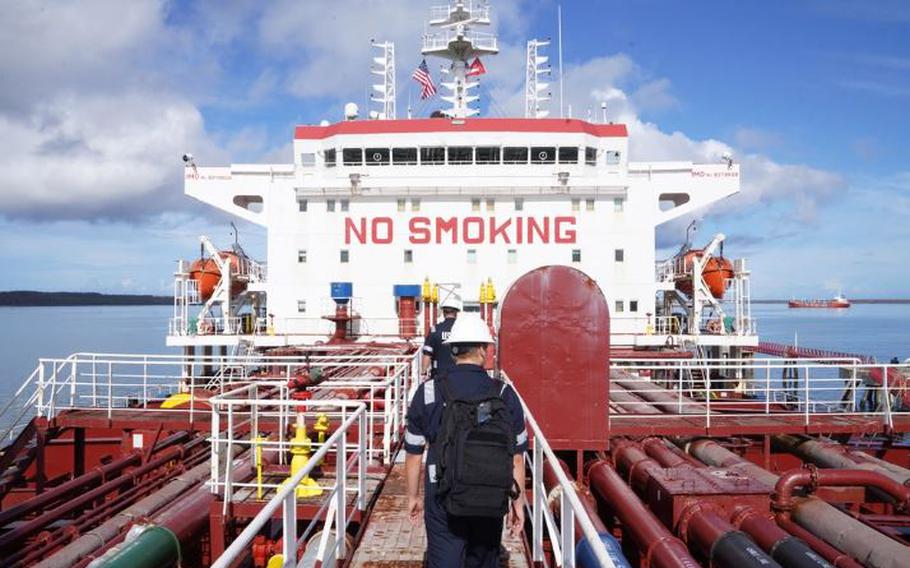Community News
U.S. Coast Guard ensures safe operations of commercial vessels as Typhoon Mawar recovery continues
Community First June 5, 2023

Marine Science Technicians stationed at U.S. Coast Guard Forces Micronesia / Sector Guam conduct a routine certificate of compliance inspection on a vessel in Apra Harbor on June 1, 2023. The U.S. Coast Guard ensures the safe operations of commercial vessels as Typhoon Mawar recovery continues. (U.S. Coast Guard photo by Petty Officer 3rd Class David Graham) ()
SANTA RITA, Guam — Amidst the dynamic challenges faced by Guam's strategic port, a team of inspectors from U.S. Coast Guard Forces Micronesia Sector Guam and Marine Safety Detachment Saipan conducted routine certificate of compliance inspections on two vessels on June 1 and 2, ensuring the safety and security of the port and its surrounding waters as the units begin to return to steady state operations following Typhoon Mawar.
"Guam's port serves as a lifeline for the island, facilitating crucial commerce and playing a pivotal role in storm recovery efforts for the people of Guam. Its significance goes beyond local trade; it is intricately tied to the strategic environment of the Western Pacific," said Capt. Nick Simmons, commander of U.S. Coast Guard Forces Micronesia Sector Guam and Captain of the Port. "We recognize the port's importance in maintaining regional stability and promoting economic prosperity. Ensuring the safety and security of this vital gateway is not only a responsibility but a strategic imperative, as it directly impacts the resilience of Guam and the entire Western Pacific region in the face of evolving challenges."
U.S. Coast Guard FM/SG crews fill a significant role in ensuring the safety of Guam's waters by regularly conducting inspections and safety checks on commercial vessels coming into Apra Harbor. A COC is a certificate the U.S. Coast Guard issues to non-U.S. flag tank vessels carrying liquid bulk hazardous cargoes, such as crude oil or other petroleum products, chemicals, liquefied gas, or compressed gas. The COC is not a required international certificate; it is a unique certificate needed for non-US flag tankers to operate in the navigable waters of the U.S. The goal is to ensure that no substandard tank vessel operates in the U.S. and threatens its coastline and territorial waters. A valid COC must be aboard the ship when loading, discharging, or carrying any liquid bulk hazardous cargo into a U.S. port.
The FM/SG Prevention Department ensures these vessels have all the required contracts, certificates, and approved response plans. These inspections ensure the vessel crew complies with international regulations and is prepared to respond to emergencies to maintain the crew's safety and preserve the environment.
The U.S. Coast Guard Captain of the Port opened the commercial maritime port of Guam, allowing port activities to resume on May 28, four days after Typhoon Mawar made an impact with maximum sustained winds of 140 mph and gusts of up to 165 mph, the equivalent of a Category 4 hurricane. The reopening of the port and resuming the flow of supplies entering Guam was a top priority for the U.S. Coast Guard as the port serves an essential role in the restoration process for Guam. Thirteen vessels have entered Guam's port since the reopening, and the U.S. Coast Guard continues to assist port partners in establishing consistent operations by ensuring compliance with applicable regulations while promoting maritime safety, security, and stewardship in the port.
"Our commitment to conducting rigorous inspections on large commercial tank and cargo vessels calling on Guam is rooted in our unwavering dedication to ensuring the safety and security of the port and its surrounding waters. These inspections play a pivotal role in safeguarding the environment, preventing pollution, and upholding international regulations," said Lt. Cmdr. Al Blaisdell, chief of prevention, U.S. Coast Guard Forces Micronesia Sector Guam. "By maintaining strong partnerships with the port partners here, we work hand in hand to promote safe maritime operations, protect vital infrastructure, and foster a resilient and thriving community. Our focus on compliance not only enhances the port's operational efficiency but also reinforces our commitment to maintaining a secure and sustainable maritime environment in Guam and beyond."
U.S. Coast Guard Forces Micronesia/Sector Guam comprises nearly 300 personnel throughout the response, prevention, administrative, and logistics departments supporting the Joint Rescue Sub-Center, three fast response cutters, a small boat station, and a marine safety detachment in Saipan. The unit provides a significant portion of the U.S. Coast Guard's enduring regional presence serving the people of the Pacific by conducting our six major operational mission programs: maritime law enforcement, maritime response, maritime prevention, marine transportation system management, maritime security operations, and defense operations.
-USCG-